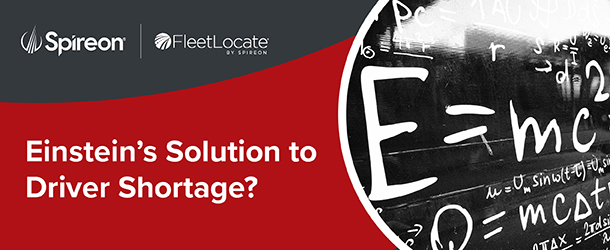By P. Sean Garney, Scopelitis Transportation Consulting LLC and Safety/Regulatory Consultant to Spireon, Inc.
Some of you likely are aware of Einstein’s definition of insanity—doing the same thing over and over and expecting different results. One can argue that in the trucking industry, Mr. Einstein’s views are applicable to how we are continually discussing the issue of driver shortage and ways to overcome it.
The latest deliberations in Congress on the Reauthorization of the Highway Bill have included discussions on the DRIVE-Safe Act, legislation that was introduced in the last two congresses to allow for younger drivers—from ages of 18-20— to operate commercial motor vehicles in interstate commerce under specific parameters to include advanced training and safety technologies, as well as performance benchmarks. This topic, as you can imagine, has engendered much discussion and debate as to whether it is a worthwhile endeavor to undertake.
As a part of the deliberative process in Congress, 117 organizations representing all levels of the U.S. supply chain sent a letter to congressional leaders encouraging them to pass the DRIVE-Safe Act, given the industry challenges on driver shortage, which was exacerbated by the impacts from the COVID-19 pandemic. The numbers reflect the acuteness of this problem, recent industry estimates note more than 60,000 truck drivers are needed immediately, and by 2028 this number will balloon to 160,000. The result of which, when coupled with retirements and growth, is the industry will need to hire approximately 1.1 million new drivers over the next decade, a very tall order by any measure. To add an exclamation point, the American Transportation Research Institute’s most recent report on top Industry Issues notes that Driver Shortage continues to be the industry’s number one concern.
During the negotiations of the Highway Bill on the Senate side, a compromise amendment was passed by the Commerce Committee representing much of what was in the DRIVE-Safe Act. The amendment would support a younger driver apprenticeship program complete with safety technology and training requirements. On the House side, there currently is no companion provision, meaning if nothing changes on the House side through its committee deliberations, resolution on this issue will need to be worked out in conference when the two houses of Congress meet to negotiate the final passage of the Bill.
Even with enhanced safety safeguards in place, there still is significant opposition on this issue, primarily coming from the Democrats in Congress, as well as the unions and safety advocates. However, there seems to be a willingness by some in Congress to support a compromise approach.
With the advent of new technology, monitoring, and improved training techniques, there are many more tools today to help fleets and drivers to be safer than they ever have been. To address the acute challenge of filling the seats with qualified drivers, we need to adapt our thinking to explore alternatives, and people need to understand that it does not have to be an either/or option. We can have an environment where younger drivers can also be safe drivers, and Mr. Einstein would expect nothing less of us to push for solutions.

